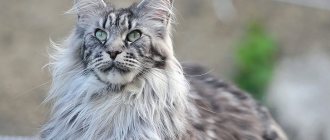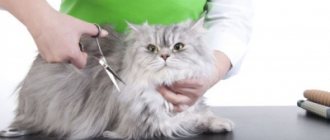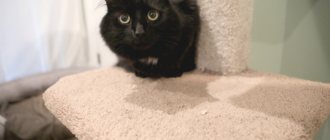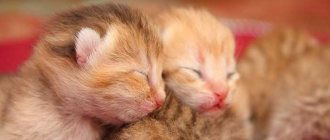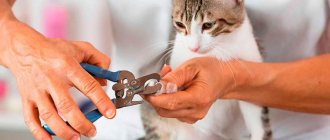If you need a loyal cat, then this is just about Russian blue cats. They become attached to one or two owners and will always be there, but do it unobtrusively, without fanaticism.
Russian Blue cats are not aggressive, they do not rush around the house, they do not meow for no reason, in general, chaos and chaos are not about them!
But before you bring such a pet into your home, we recommend reading our review about the care and maintenance of this beautiful breed. Find out all the pros and cons of these cats, maybe you expect something else from them and then you will simply be disappointed in these cats.
History of the Russian Blue cat
The Russian Blue cat is a short-haired feline. This breed is one of the oldest, so the history of its origin is shrouded in many contradictions. There are versions according to which the blue cat appeared in Spain, America or Russia. Cats with a similar appearance were seen and passed off as real blue cats on the Kola Peninsula, European countries and several regions of Russia. This has happened since the 16th century and is still happening.
the name of the breed may not indicate its Russian origin
Some breed lovers believe that the Russian Blue is an original Russian breed. But there are those who are inclined to other versions. Some felinologists claim that the Russian Blue was first bred in England, but the cat was not found in the wild nature of this country. The fact is that since the middle of the 19th century, the blue cat has been mentioned in English literature. Many clubs around the world love and revere these animals. For these reasons, it is unclear whether the blue cat is really Russian. After all, there is a possibility that this animal comes from Foggy Albion.
It is known that British sailors brought beautiful gray-blue kittens from Arkhangelsk for sale. The animals had incredible appearance and easily caught rodents, so there was always a demand for these animals. But this cannot speak about the Russian origin of the breed. After all, it is also possible that the kittens first appeared in England, and then came to Russia. There is also an explanation for this version: in 1553, English industrialists opened a business related to wood processing in Arkhangelsk. In addition, there is a legend that Catherine II gave a blue kitten to the royal family of England. This may mean that blue cats came to England from Russia.
At the end of the 19th century, Arkhangelsk cats were brought to the exhibition for the first time. After this, the popularity of the breed increased significantly, and their import from Russia increased. For several decades, blue cats were exhibited in the same class as British cats (chartreuse). Such confusion occurred due to the similar color. And since breeders were afraid of the extinction of British blue cats, crossbreeding with Russian cats often occurred. Later, Russian blue beauties were divided into two categories: the British type and the lightweight foreign type. The British version of Russian cats was considered heavier. The lighter version was called “Foreign Blue” (this name may still appear today).
Russian Blue cats have long been judged according to standards
At the moment when the Russian Blue could change and lose its characteristic features, it forced lovers of the breed to unite. A group of connoisseurs formulated a new standard (1965). Some points of this description are also found in modern standards. Currently, the breed is bred all over the world. Some European breeders exchange “fresh blood” with Russian nurseries. This suggests that the rock is firmly entrenched.
Reproduction
Puberty of Russian Blues occurs quite quickly. After which the animals melodiously purr remind you of natural instincts. This is how cats call cats, and vice versa. Males are very gallant gentlemen. They can groom a cat for several days to get her to like her. Since the breed is not artificially bred, pregnancy and childbirth occur without complications in animals. As a rule, 4-5 kittens appear in one litter. Russian Blues are the best mothers in the world. They take very good care of their children.
Description of the breed
Not many Russian catteries are engaged in serious breeding work with blue cats. This happens because the owners of a purebred pet do not know how to “see” the breed. And experienced breeders and nursery owners are not always in a hurry to invest in phenotype exchange. Therefore, there are not so many purebred blue cats in Russia. Both purebred beauties and cats with “average” performance are brought to exhibitions and shows. Felinologists clearly separate these groups, because purebred animals are more valued. For this reason, the price of Russian Blue cats is considerable.
Like any other breed, blue animals are judged according to a standard. There are several standards in total, but basically their points are the same. The judges evaluate the length of the body and tail, the shape of the head and paws, the location of the ears, color, etc.
Appearance
The main feature of Russian cats is their color. According to the standard, the color of the animal's coat should be ash-blue. The fur of these cats is short, but thick and velvety (like plush). Despite their short coat length, blue cats have both undercoat and guard hairs.
The color of Russian blue cats is called differently: from gray-blue to hazy blue
The cat's head is long and flat on top. It is believed that the shape of a cat's head resembles the shape of a blade (but this formulation is more suitable for the shape of the muzzle).
If you draw lines from the eyes to the tip of the nose, you will get a triangle, upside down. The animal has large, expressive, wide-set green eyes. Some felinologists call this eye shape round, while others call it almond-shaped. The blue cat's ears are large and pointed. The outer side of the ear is covered with hair to match the main color, and the inner side is pink (with a small amount of hair).
Cats of this breed have a neat build. The body of the animal is medium in size, the body is slightly elongated. The cat's neck is straight and long. Blue cats have long legs; in general, the animal is characterized by a proportional physique. Paws oval (almost round). Sometimes, due to the inaccuracy of the name of the paw shape, disputes flare up between felinologists. The tail of this breed is long, thin and tapered to the tip.
Character of the breed
Despite their thoroughbred, Russian blue cats are quite friendly
Russian Blue cats lead a very active and independent life. Such a pet will love its owner and delight everyone with its purring, but if the cat is left alone, it will not suffer from melancholy. The animal will find something to do without human intervention. Therefore, these cats are ideal for those who cannot be at home all the time. These animals react calmly to loneliness.
However, such “indifference” is only feigned. A blue cat will value and respect its human. But if a stranger comes into the house, the cat may not like it. The peace-loving blue beauty will not rush into a fight, but will try to hide in a secluded place. She will come out of her hiding place only after the stranger leaves.
The blue cat is an intelligent animal. Such a pet will need to know everything. The cat will definitely study every little thing. When exploring an object, the pet will sniff it, examine it and even taste it. If possible, the cat will try to study the object from the inside. In addition, the blue pet will also study family members. He is able to remember intonation and gestures. Such animals understand everything that their owner wants from them. These cats also love to play. If you do not offer your pet a toy, the cat will find something to play with (a fly on the window, a sunbeam, etc.). If there are rodents in the house, it won't last long. The cat will catch the pests one at a time.
blue cats are excellent mouse hunters
The pet will not offend the child, even if the baby is very annoying. If the cat experiences discomfort due to excessive activity of children, then it will simply hide. These cats will not offend other inhabitants of the house either. The Russian cat is open to communication with any living creature, so the blue pet will not touch the ferret and turtle. The cat will not catch fish from the aquarium. The maximum is studying those floating through glass.
Character specifics
At first, the Russian Blue in England was also called the “wild gray rabbit” - not so much for its color, but for its timidity. This drawback has been eliminated, but even today this breed prefers quiet places. These cats are a little distrustful and can “look closely” at strangers for a long time. Russian Blues do not impose themselves on their owner, but come up for a portion of affection when they want it.
They tolerate loneliness well and do not play dirty tricks when left at home alone. While mastering the territory, the pet may accidentally ruin something, but if the owner expresses dissatisfaction, the cat will not repeat the mistake.
Purchasing a Russian Blue kitten
Pet lovers can look for a baby Russian Blue cat for themselves (to raise and care for). And beginners and professional breeders are looking for such kittens for breeding. Experienced cat breeders often know the standards, but amateurs may not understand the characteristics of the breed. Therefore, before you start searching for a kitten, you need to familiarize yourself with the basic criteria by which you can make the right choice. It is very important not to make a mistake, since a purebred animal cannot be cheap. But the price may also depend on the prestige of the nursery.
If you want a purebred kitten, then look for nurseries on Avito, then look on the Internet for everything about these specific nurseries, exclude those that have bad reviews, then call and go to choose a kitten.
VASY, forum user
https://forum.auto.ru/brothers/440561/
Criterias of choice
There are several main criteria for choosing a cat:
- Nursery conditions.
- Appearance of a kitten.
- Appearance of the kitten's parents.
- Documentation.
to buy a purebred cat, and not a simple gray kitten, you need to be guided by a number of rules
The nursery should be clean and there should be no foreign odors. Kittens offered must look neat and well-groomed. If any wounds, dull fur, etc. are obvious on the baby, then perhaps he was not kept properly. In addition, you need to pay attention to the characteristics of the breed. There should be no white or black spots in the baby's color (even white paws are unacceptable). The base coat may appear slightly striped, but this is not critical as the residual tabby will subside over time. The kitten's tail should be flexible and soft (there should be no kinks). In addition, pay attention to the color of the hairs. The very edge of the hair should be “silver” (silvering). This trait in the color of blue cats appears in kittens from 3 months and persists throughout their lives. The cat's eyes should be green (but not yellow). The kitten must also behave actively (playfulness, jumping ability, etc.).
The Russian Blue cat kitten is friendly and calm. The animal should not “shy away” when new people appear. And even more so, the kitten should not scratch, bite or growl.
If it is important for you to know what the kitten will be like when it grows up, ask the breeder to show its parents. A healthy kitten will only be born to a healthy cat, which means the baby’s mother should also look good. And also the mother must have veterinary documents (make sure she has been vaccinated). If the breeder says that the kitten or its parents have some kind of title (or award), ask for supporting documents (for example, a diploma of participation in an exhibition). In addition, if one of the cat’s parents has a pedigree, then a conscientious breeder will offer to familiarize himself with it (if a kitten is purchased, a copy of the pedigree must be handed over). And the breeder must also enter into an agreement with you, which will indicate the rights and obligations of the new owner (the need for castration, participation in breeding work, terms of purchase and sale, etc.).
If the kitten you like has yellow eyes, but the breeder assures you that this will go away, then you are being deceived
At what age can you adopt a kitten?
A conscientious breeder should not sell/give away kittens before three months of age. If a nursery gives away a kitten under this age, it means the owner of the nursery wants to save money on its maintenance. The need to get three months is due to a number of reasons:
- vaccinations;
- immunity;
- socialization.
Each kitten must be accompanied by a veterinary passport with vaccinations. Basic mandatory vaccinations are given up to 12 weeks. In addition, if the kitten you like is suitable in age, the breeder must provide contact information for the veterinarian who administered these vaccinations. Another important reason for this rule is immunity. The fact is that early weaning of a kitten from its mother can lead to negative consequences. With cat's milk, the baby receives primary immunity. If the kitten is fed other foods too early, digestive tract problems may occur.
The cat also teaches its cub some skills: going to the litter box, licking itself, playing, etc. Weaning a kitten early will lead to the development of a problematic character.
It is not recommended to adopt a kitten under 3 months old
How to choose the right kitten
It is advisable to buy a Russian Blue from a specialized nursery or from a trusted breeder with an impeccable reputation. At the time of sale, the baby must have a veterinary passport with vaccination marks and a metric confirming its breed.
The three-month-old blue kitten has green eyes, a straight tail without kinks and fur with traces of silvering. The physical health of the baby can be judged by a soft belly, clear eyes and clean skin without scratching or redness.
Kitten care
Caring for a kitten of this breed is not as difficult as it seems at first glance. Usually, by the time the kitten is weaned from its mother and moves to a new home, it is already accustomed to the litter box and knows the scratching post. Therefore, new owners can only show the pet where its toilet, place to sleep and bowls of food are located.
To ensure safety, all wires, household chemicals and small objects that the kitten might mistake for a toy are hidden from the kitten. And to make caring for the animal easier, they purchase in advance:
- scratching post;
- tray and filler;
- bowls for food and water;
- house or bed;
- toys;
- carrying bag;
- hygiene products;
- grooming tools.
Keeping a pet
Russian blue cats are animals with good health. They do not have genetic diseases. Of course, any cat can get a common cat disease, so it is very important not to violate the conditions of keeping the pet. Blue cats do not like closed spaces, so do not leave your pet in a locked room.
Many people I know lock their cat in a separate room when they are cutting meat in the kitchen. After all, the cat may start begging for it, and the owner may not resist. And I allow my cat to come into the kitchen at any time. Of course, she loves any meat and will lick her lips at the sight of it, but she will not climb onto the table and steal it. I allow the cat to sit at the table (on a chair) and just watch. And for good behavior after cooking, I can give you a treat. If she is accidentally locked out, she gets offended.
You can buy or make a play set for your cat yourself. The animal should have a separate place for rest and entertainment. The complex must have a house (the cat can hide there from annoying children). You also need a soft bed for sleeping. All cats love to climb to different heights and sharpen their claws, so slats, ladders and scratching posts are also desirable.
Video: Russian Blue cat named Luna
Nutrition
A cat's diet must maintain a balance of nutrients. If you decide that you will feed your cat with store-bought food, then try to choose the best types. The food must contain proteins, fats, carbohydrates, vitamins and minerals. Read the ingredients carefully. The product must not contain iodine or copper. These microelements can make a cat's fur appear yellowish. When feeding store-bought food, it is important to remember that the daily diet should consist of 3/4 dry food and 1/4 wet food.
It is not recommended to combine homemade food with store-bought food. Firstly, it is difficult for a cat to switch from one type of food to another. This can affect the health of the digestive system. And secondly, if a cat’s fur becomes dull or diarrhea begins, you will not be able to understand which food she has such a reaction to.
Problems with wool can also arise with natural nutrition. The silver-blue coat may turn brown due to eating too many legumes or liver. This pet should not be given whole milk. A fatty product will also affect your health. Moreover, adult cats generally do not tolerate milk well. Instead, you can offer her fermented milk products (kefir, fermented baked milk, lean sour cream). It is not recommended to feed your cat fatty fish and other seafood. All cats love the smell and taste of fish, but it must be given correctly. The fish should be boiled, unsalted, and there should be little of it. From excessive consumption of fish, cats can develop urolithiasis (especially in male cats). But you can still include it in your diet, since it contains omega-3 and omega-6 fatty acids (good for the heart).
I buy trout or herring for my cat. I boil the required amount in unsalted water (trout steak or half a fish of herring). When it cools down, I separate it from the bones (if you cook for more than 30 minutes, the bones come off on their own) and divide into portions. I get 3 servings (1 tablespoon is a serving). I pack the pieces into processed cheese boxes and freeze them. I defrost it before feeding it - once a week.
Not only its appearance, but also its health depends on proper nutrition of a cat.
In addition, blue cats can be fed lean meat (chicken, turkey or beef). If possible, you can grow cat grass (such as oats). In addition to vitamins, it contains a lot of fiber. This herb is useful for cats, as it helps remove hair from the body. Arkhangelsk cats love to eat. Therefore, it is important to control the amount of food you eat. It is best to feed your pet 2 times a day (adults, but kittens can do it more often). One of the features of the breed is remembering the routine. The cat will definitely remember what time of day it is given food.
Appearance care
Short, soft hair allows Russian cats to take care of their hygiene independently. This is especially true for fur - the pet is able to lick it. But to prevent the wool from getting into the gastrointestinal tract, the animal needs help. A natural bristle brush is suitable for this. The Russian cat sheds twice a year: in spring and autumn. During the shedding period, you need to comb out the undercoat. Moreover, first comb the cat against the fur, and then in the direction of its growth. After the procedure, you can wipe the cat with a flannel cloth or a special mitten. The animal will be grateful for combing. When the cat does not shed, you can brush it once a week.
Russian Blue cats don't really like water. Therefore, your pet does not need to be bathed often (you can not bathe it at all). Periodically, for example, if the fur is dirty, you can wash your pet. To bathe an animal you need a special cat shampoo (you can use dry shampoo).
Russian blue cats do not like water treatments, but they love brushing
If there is a scratching post in the house, then the cat can handle the “manicure” on its own. You need to make sure that the claws do not grow too large. If the scratching post does not give the desired result, the animal's claws can be trimmed using scissors or a nail clipper. The edges of the cuts can be sharpened with a file (so as not to be scratched). The sharp edges of trimmed claws can injure the cat. There is no need to walk such a cat. Her cautious and fearful nature can lead to the cat simply running away, frightened by any rustle. But if you decide to walk your pet, then don’t forget about the leash. The collar can be uncomfortable, so it is better to attach the leash to the harness. Remember that sunbathing causes a cat's fur to turn brown.
It is important to keep the tray clean. The silver pet is very picky about its toilet. If the tray does not seem very clean to the cat, then it will do its business in another place. When choosing a filler, you need to study its packaging. Almost any type of litter is suitable for short-haired cats.
What to feed cats?
If you prefer natural feeding, your pet should receive a dairy and meat dish at one meal. Meat products can be represented by chicken or lean beef. As dairy food, you can give low-fat sour cream, kefir, cheese, cottage cheese, kefir or natural yogurt. But fatty fish and whole milk should not be given to animals.
Experienced experts recommend using high quality feed. Thanks to them, it is very easy to preserve the beauty of wool.
Vices of the Russian Blue breed
Russian Blue cats do not have a predisposition to any specific diseases. But any animal can still get sick. Therefore, there is no need to ignore veterinarians. Periodically (for example, once a year), you can take your pet to the veterinarian for a routine check-up. This will help avoid illness, and if it turns out that the cat is already sick, then thanks to a preventive visit, treatment will be started earlier. Moreover, the veterinarian remembers the necessary vaccinations better than the cat owner.
Periodic visits to the veterinarian will help avoid many diseases
Congenital abnormalities of blue cats can be defects associated with the structure of the skeleton:
- breaks, knots on the tail;
- sagging of the spine;
- curvature of the jaw;
- malocclusion;
- small stature.
With all these defects, a cat may well live to old age. They have special meaning only in cases where the cat was planned to be presented at an exhibition. Judges and experts will not allow the animal to participate. Problems in shows can also arise due to problems with the coat. The coat of this breed may turn brown. Otherwise, these cats have good health and strong immunity.
Defects in appearance
The main characteristic feature of the Russian Blue cat breed is its rare color. For this reason, a deviation from the standard is considered a serious defect. Sometimes two purebred representatives of the breed give birth to blue kittens with a white spot. This does not mean that one of the parents is a common impostor. Such a defect can appear in offspring in cases where both parents are carriers of the spotting polygene. This gene cannot be identified in advance, so you have to wait for the first litter. Kittens with such a marriage may have all the documents, including a pedigree, but breeders will immediately castrate/sterilize them.
Blue kittens with a color defect are sold at an even higher price than regular kittens of the same breed. But such animals can only become pets, since they will not be allowed into any exhibition with this defect.
cats with color defects cannot be bred
A cat will not be allowed to participate in the exhibition if it has at least one of the defects related to appearance:
- cryptorchidism (failure of the testicles to descend into the scrotum);
- strabismus, blindness, cataract, entropion (turned-in eyelids);
- oligodactyly (lack of fingers), syndactyly (fusion) or polydactyly (excess);
- jaw deformation (undershot, overshot, etc.).
Long-haired representatives
It is worth knowing that there are also long-haired representatives of the Russian Blue breed. Nibelungs were bred in the late eighties by the Americans. And in the nineties, the breed was officially recognized throughout the world. The character of the Russian Blue Longhair cat is not too different from other breeds. Such animals also adore their owners, they are calm and balanced.
But care for long hair is more thorough. It must be combed regularly with a metal brush. In order to preserve the color of animals, they should not be allowed to remain in the sun for a long time, otherwise the fur may get a rusty tint. Very often, owners give their pets mineral supplements. However, it is worth remembering that you should avoid preparations with seaweed and iodine.
Breeding
One of the main rules of mating is to mate only with an individual of the same breed. Currently, there are many clubs for fans of this breed, so choosing a suitable partner is not difficult. Russian blue cats do not have any particular difficulties with mating. Representatives of this breed are too shy and calm to fight or argue with the cat. Usually mating occurs on the territory of the male, so the owner of the cat should worry about the trip . Cats reach sexual maturity at 1.5–2 years. After this, you can start looking for a partner. Sometimes, due to the lack of opportunity to find a Russian Blue cat, cats are bred with males of another breed, but this is highly not recommended.
In almost all felinological systems such matings are prohibited. Kittens will not receive a pedigree. You will get mestizos.
curious, forum user
https://mauforum.ru/viewtopic.php?f=130&t=6390&hilit=scottish&sid=f508263d9a915a2feb53fd97f057bb57&start=10
a suitable cat can be found from the same breeder where the cat was purchased
Criteria for choosing a partner
In order to find a worthy partner for your cat, find out what nurseries/breeders there are in your city. Study the reviews of those who have already contacted these breeders. If nothing alerts you, start calling. You can ask any questions you may have by phone. If the nursery owner avoids answering any question, then perhaps he has something to hide. Once you have decided on a nursery, go to the desired address. Particular attention should be paid to the following nuances:
- appearance;
- pedigree;
- cat experience;
- documentation.
It is necessary to examine the appearance of the proposed male. The cat must be clean, without any deviations from the standard and without external damage (abrasions, bald spots, wounds). The animal must be active and look healthy. The cat must have a veterinary passport with notes on all vaccinations given. In addition, you can ask for the pedigree of the cat and its parents (if network). If there is a pedigree, the owner of the animal will offer it himself. Only with the help of this document can you understand that the cat is truly purebred. This will guarantee that the mating will produce beautiful blue kittens.
In addition, you can find out from the owner about the cat’s experience. The ideal option is an already untied cat. The male must know how and what to do with the cat. If the mating is successful, the cat's owner will need to give one kitten from the resulting litter (at the choice of the male owner) or a certain amount. In some cases, an agreement is concluded between the parties, which stipulates all these conditions.
How often can a cat give birth?
To prevent the cat from getting sick, you need to control the frequency of births
Cats can give birth 3-4 times a year. But this usually happens during uncontrolled matings, when the animal leads a street lifestyle or has free access to the street. In addition, some (not very caring) breeders use the cat’s ability to give birth frequently for their own selfish purposes. But frequent childbirth can exhaust the cat, its health will weaken, and this can lead to the development of a number of female diseases. To prevent this from happening, you need to control the number of matings of the animal.
Experienced breeders who are sensitive to the health of their pet organize mating of a Russian Blue cat once a year.
Instead of an afterword
Funny and smart animals are wonderful and loyal friends. The breed has so many advantages that it is suitable for absolutely all families. They are great with children and never show aggression. And kindness and loyalty are the main qualities for a pet. Russian Blues treat their family with tenderness. They will never refuse the opportunity to sleep in the arms of their owners, curled up into a ball, which causes tenderness and delight in people.
Thanks to the cleanliness of the animal, even allergy sufferers can get representatives of the breed. And the love of cats for children and the desire to participate in all games with children make it possible to take such a pet into families with children.
Castration and sterilization
Castration/sterilization is an operation to remove the sex glands. This procedure is carried out in a number of cases:
- breeder (if the animal is not allowed for breeding);
- owner of a pet (if kittens are not needed);
- for medical reasons.
At the initiative of the breeder, it is possible to sterilize a cat that is not a carrier of a pure phenotype. For example, if a cat has a white spot in its color or there are doubts about its thoroughbred. To avoid spoiling the purity of the breed, a cat with disorders should not give birth. The same goes for cats. The owner of a domestic cat can initiate neutering to prevent the cat from suffering during heat. Females try to preserve women’s health in cases where kittens are expected from her. And if the owner does not need such a replenishment, then the cat will be sterilized. And cats are sterilized for the reason that they mark their territory (because of this, there can be a strong unpleasant smell in the apartment).
Russian blue cats are very showy animals, but like any other cats, they can mark their territory
A veterinarian can give medical indications. For example, if a female is diagnosed with a female disease (this usually happens at an older age). This operation is inexpensive (from 1000 rubles).
At what age is it recommended to do it?
If we are talking about kittens in a nursery, then the owner of the organization can organize sterilization even for small kittens (3-4 months). But this is not entirely correct. Surgery to remove the gonads is recommended after the internal organs have formed. If, for example, the cat’s internal systems have not yet fully formed, then after the operation they will not form correctly. In practice, cats begin to be sterilized at approximately 8–9 months.
My cat was spayed at the age of 9 months. I was worried that this would affect her future health, but there was no choice. The drops recommended by the vet did not help. The animal feels great, is also active and cheerful. Once every six months we go to the veterinary clinic for preventive care - the cat is healthy.
Video: how to care for a cat after surgery
Conditions for pets
Animals love all kinds of heights. In general, you should take care to create your pet’s personal space. The ideal option is a house with a roof on a hill. Cats feel completely uncomfortable if they fall asleep in an open space. You should forget about rugs and baskets. In addition, your pet will need a metal bowl, which should be very stable. It is preferable to place the tray far from the resting place, for example, in the bathroom or in the toilet.
Table: pros and cons of the Russian Blue breed
| Characteristic | pros | Minuses |
| Appearance | bright appearance, rare color, beautiful sea-colored eyes | in fact, the cat's fur may not be bluish, but simply gray |
| Character | accommodating, indulgent, shy character | the pet is a little cowardly, can hide in closets, etc. |
| Health | good health, strong immunity, no predisposition to genetic diseases identified | — |
| Kitten price | you can find kittens with a pedigree costing from 8 thousand rubles | in prestigious nurseries the price for 1 kitten can exceed 35 thousand rubles |
| Difficulties in content | the cat is not capricious, quickly gets used to the proposed conditions, does not require much | the animal is afraid of closed doors |
| Difficulties in breeding | gives birth independently and quickly, 3–4 kittens can be born in a litter | sometimes it is difficult to find a purebred partner |
Place for a kitten in the house
Purchasing a Russian Blue kitten is hardly a spontaneous decision. Therefore, before the baby arrives in the house, his place must be arranged and everything necessary for maintenance and care must be prepared.
At least three stainless steel or earthenware bowls: short for wet food, medium for dry croquettes, deep for water.
A litter tray, or better yet two - one smaller one will be needed for the kitten in the first months of life, and the second one will be used by the kitten as an adult. As a rule, kittens, when leaving their first home, are already litter box trained and all that remains is to decide which brand of litter to use. It is quite possible to accustom a kitten to an empty tray with a grid - it is useful and hygienic: the filler granules will not fly away in all directions and be carried around the apartment by their paws. In this case, the task of neutralizing the odor is always solved by a cleanly washed tray.
Hygiene items - brushes and combs, a rubber brush for combing out dead hair, nail clippers, a suede cloth for polishing, a toothbrush for animals, the necessary set of pet products and towels for washing. The owner must take care of the cleanliness of all these accessories in the same way as his own. A Russian Blue cat should be accustomed to grooming from childhood, and then trimming its claws or another bath will not be a shock for either the animal or the person.
Toys are a mandatory and important component of the kitten’s socialization process. With equal pleasure, the little mermaid will chase both an ordinary bow on a braid and the beam of a laser pointer.
Therefore, what matters is not how expensive or technically advanced the toy is. The main thing is that it is not traumatic (breakable, cutting, heavy) and has a suitable size: a kitten that is too large will not be interested, a small one can be swallowed. Russian Blue kittens in their usual environment are usually very active, playful and do not lose these qualities with age.
Games help you hone your technique for moving gracefully through space.
A scratching post is also a familiar item for a nursery graduate. The owner has the choice of design and size - from a modest column covered with rope to a multi-level playroom complex - this absolutely necessary device.
A carrying bag is indispensable as a means of transport for visits to the veterinarian, trips and travel.
A bed is sometimes not considered a necessary item: about 90% of surveyed cat owners allow their pets to sleep in their bed. But still, the Russian Blue should have an individual place to sleep, to which the animal must be accustomed from childhood. “Put a piece of paper in the middle of a football field, and sooner or later a cat will lie on it”: purrs love to lie on something, be it the owner’s favorite designer blouse or a stack of freshly ironed linen. And Russian Blues are no exception.
To avoid such unpleasant surprises, you will need a crib or basket for the baby. Other useful items - harnesses for walking and swimming, a collar with an address medallion, warming and antistatic bedding - can be purchased later.
Cats use their sense of smell to a greater extent than their other senses to navigate unfamiliar environments. Having gotten used to the smell inherent in the owner and relating it to a calm environment, the baby will quickly get used to the new home and begin to enthusiastically explore the new space. There is no need to prevent this, but such educational excursions should not take place unsupervised.
The owner must use every opportunity for communication and joint games, not forgetting the words of encouragement for any, even the smallest, achievement of the baby. Very soon the kitten will begin to associate home and family with the most pleasant sensations - delicious food, love, a sense of comfort and security.

